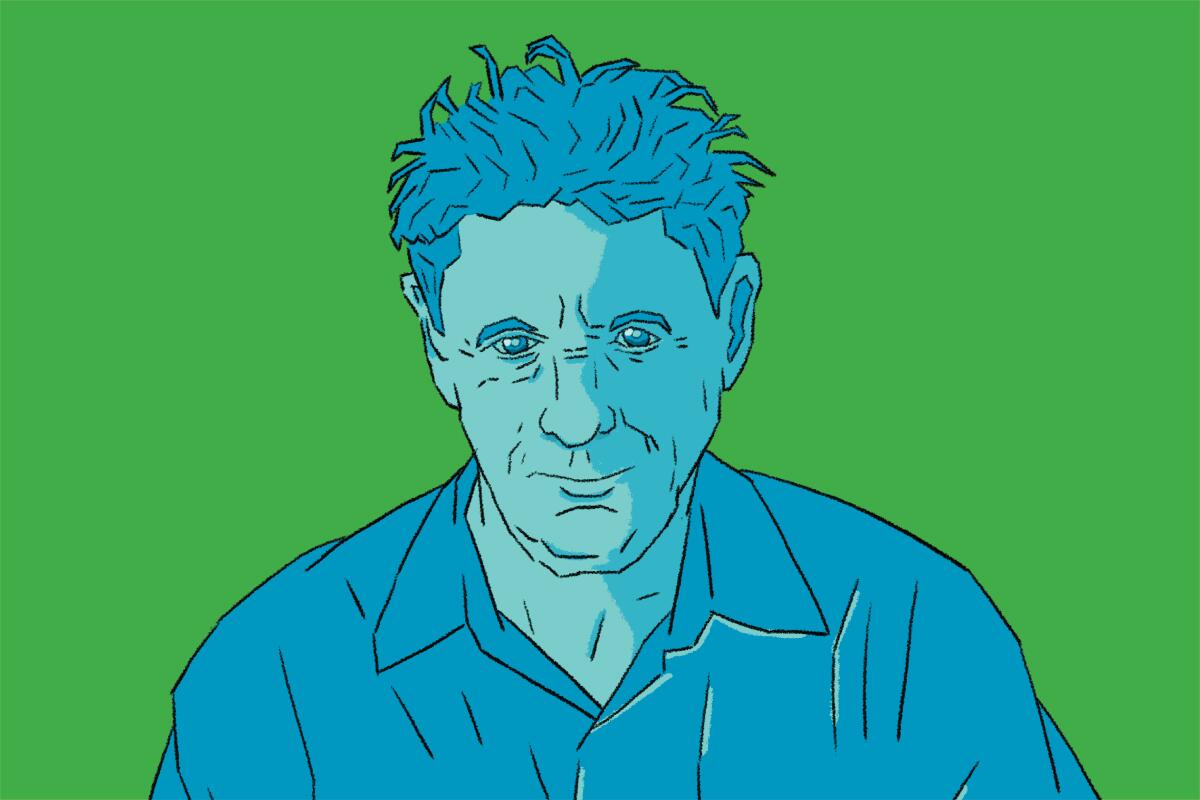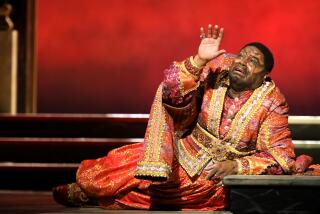Philip Glass and ‘Einstein on the Beach’: How one opera changed everything

Easily the most important opera of the last half century, “Einstein on the Beach,” at least at first, meant far more to those who witnessed it than to the art form itself, which couldn’t have cared less. Almost nothing about what composer Philip Glass and director Robert Wilson put onstage was opera.
“Einstein” has no narrative. “Einstein” has no Einstein, even though a great many onstage are dressed in the iconic image of frizzy-haired scientist. “Einstein on the Beach” has no beach. Glass’ relentlessly fast and loud score is four hard-driving hours of Minimalism. Spoken text comes from the sputtering of mid-1970s New York AM radio, cut up. Sung text consists of a chorus counting rhythms or the solfège syllables of pitches. Wilson’s images revolve around a train/spaceship, trial/prison and field, although at one inexplicable point, a revolutionary Patty Hearst, rifle in hand, finds herself in the action.
At the summer 1976 premiere in Avignon, France, Glass likened the feeling in the theater to the euphoria that accompanies childbirth. A lot of us — quite a lot of us, as a matter of fact — will not dispute that. At the time, Glass brushed off questions about whether he and Wilson really intended “Einstein” to be an opera, given that music, imagery, stage decor, lighting, dance and other movement had little, if anything, to do with one another. In his autobiography “Words Without Music,” the composer insists that “Einstein” neither asked for nor needed an explanation. “And we never tried to make one.”
It’s an opera. That is, if you take opera to be theater that trusts music. In a sense, “Einstein on the Beach” is even more musically trustworthy than traditional opera, being all but unstageable without Wilson’s production. What lasts is the score. And the trust, which makes “Einstein” essential in 2020, our fateful year when trust has become among our most desperate needs.
In her essay “Against Interpretation,” published a decade before “Einstein,” Susan Sontag contends that “to interpret is to impoverish.” Interpretation turns the world as it is, “the world,” as Sontag puts it, into “this world,” the dimmer one of our making. What is needed, she concludes, is to recover our senses. “We must learn to see more, hear more, feel more.” That is “Einstein on the Beach” in a nutshell, an opera that is all container and no content.
The work consists of three iterations of its basic scenic elements. A slow-moving train is followed by a trial scene lorded over by two judges, one an older Black man, Mr. Johnson, who was also the engineer of the train, the other a child. Then comes the field, an empty stage used for dance.
The second time around, two lovers stand at the back of a night train, entranced, until the woman suddenly takes out a gun and shoots the man. The trial set is more elaborate, with a prison attached and Patty Hearst’s appearance. The field is the same except a small flying saucer that glided by the first time is now larger and thus getting closer.
The third time is different. The train has become a building, and Glass makes space for a wailing saxophone. The trial is a bed represented by a horizontal beam of light that ever so slowly rises like a giant clock hand and then lifts into space, accompanied by a rhapsodic organ cadenza. The train turns into a spaceship, and the opera’s spectacular finale is a riot of lights and movement, characters flying and transported in transparent tubes.
In the five entr’actes — Wilson calls them Knee Plays — two women, dressed as Einstein, stand or sit in a square of light and recite the radio text, which is by Christopher Knowles, a remarkable poet who was Wilson’s ward. Samuel M. Johnson, the actor who played Mr. Johnson, wrote his own texts about life and love that can move a listener to tears. Lucinda Childs, who appeared in the Knee Plays and danced in the first production, also added a text about bathing caps in a “prematurely air-conditioned supermarket” that she repeats 30 times. For the first revival of “Einstein” at the Brooklyn Academy of Music in 1984, Childs became the choreographer of the brilliant dances and a full-fledged third partner of the production. A solo violinist is a key figure, as well, and also Einstein. The instrumental ensemble is winds and electric keyboards.
Coronavirus may have silenced our symphony halls, taking away the essential communal experience of the concert as we know it, but The Times invites you to join us on a different kind of shared journey: a new series on listening.
The original title was to have been “Einstein on the Beach on Wall Street.” On some level, interpreters, of which there have now been many, have reason to see the opera as a comment on the emptiness of commercialism and an antiwar, post-apocalyptic statement. Nevil Shute’s bestselling novel, “On the Beach,” is a warning about nuclear war. In the 1960 movie version, Fred Astaire, a disaffected, alcoholic scientist who worked on the bomb, is asked who caused World War III, the radiation of which is emptying the Earth of humanity. “Einstein,” he answers bitterly.
The spectacular spaceship scene in “Einstein,” a wow moment like few I’ve ever witnessed onstage, ends with an atomic explosion, but the opera’s epilogue is Mr. Johnson describing lovers on a park bench, their lips pressed “in fervent osculation.”
Everything about “Einstein on the Beach” seemed new and revelatory in 1976. It was the U.S. bicentennial. American opera was moribund. When the Metropolitan Opera presented the touring production that fall after an ecstatic European tour, in which every seat at every performance was sold out, the company hadn’t performed a new American work in decades. Here was a new beginning for opera in America.
Audiences everywhere spoke about “Einstein” changing their lives. Sontag, an opera lover, once told me she was mystified by it in 1976, not so sure that this wasn’t against “Against Interpretation.” But a couple of years later she asked Wilson if he might suggest an actress for her upcoming film project. He recommended Childs, which led to the two women’s love affair and their profound influence on each other.
Yet the great irony, and great revelation, of “Einstein” turned out to be that this opera about the relativity of time was as much an ending, not a beginning. The culmination of the work that Glass and Wilson had been doing individually for a dozen years in the avant-garde fringes, “Einstein” launched their hugely influential careers in more mainstream opera.
For Glass, that has meant more than 20 operas, beginning with portraits of Gandhi and the Egyptian pharaoh Akhnaten and then widening into all manner of subjects, be they Columbus, Galileo or Walt Disney, or adaptations of literary works by the likes of Poe and Kafka. Wilson has spent a good part of his career re-imagining the standard operatic repertoire of Gluck, Verdi, Wagner, Puccini and Weill on the world’s great opera stages.
Opera after “Einstein” is consequently traditional. New American opera flourishes like never before, but nearly all of it relies on narrative, as if “Einstein” turned the clock backward, just as Einstein said time could. An event opera, “Einstein” stands apart. But its ethos of operatic re-imagining has stuck. The very notion that opera matters is “Einstein” bound.
After the 1984 revival, Glass and Wilson revived “Einstein” again in 1992 and, for the last time, in 2012, reaching L.A. Opera the next year. Attempts to mount it in new productions that discard Wilson’s original design and staging have failed. A goofy production in Geneva last year boasted a clown-like Einstein, a mermaid, a horse and insufferable horsing around. More recently, the outstanding Belgian new music ensemble Ictus has been touring in Europe a concert performance in an installation art setting with the singer Suzanne Vega taking all the spoken parts. The French radio broadcast I caught sounded terrific. “Einstein” lives, after all.
Starting points
“Einstein on the Beach” survives, in part, though extensive documentation.
The studio recording with most of the original performers, released as a four-LP set in 1979 and later remastered for CD, caused a sensation.
Philip Glass has put out excerpts from the 1984 BAM revival along with a television documentary made at the time on his own label, Orange Mountain Music.
The 1992 revival was recorded by Nonesuch. The 2012 revival was beautifully filmed the following year in Paris and is available on DVD and Blu-ray. Each entrances in its own way, as one follows the increased sophistication of the performers over the years. The video is surprisingly effective, a work of art in its own right.
A set of scholarly essays, “Einstein on the Beach: Opera Beyond Drama,” includes some that are illuminating, some that are massively anti-Sontag over-interpretations. It was published last year.
With live concerts largely on hold, critic Mark Swed is suggesting a different recorded music by a different composer every Wednesday. You can find the series archive at latimes.com/howtolisten, and you can support Mark’s work with a digital subscription.
More to Read
The biggest entertainment stories
Get our big stories about Hollywood, film, television, music, arts, culture and more right in your inbox as soon as they publish.
You may occasionally receive promotional content from the Los Angeles Times.








